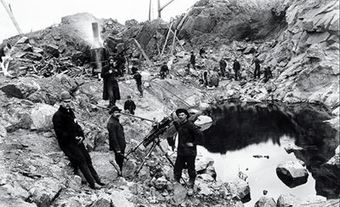Mercury
Mercury (Hg) is a silvery white metal also known as quicksilver. Mercury is named for the Roman god of commerce, travel and thievery. It has been used for over 3000 years. Its chemical symbol, Hg, is derived from the Latin word hydrargyrum, which means "liquid silver." Mercury is a naturally occurring element that is unique among metals in that it is liquid at room temperature. Below its melting point of -38.9°C it is solid white, and above its boiling point of 356.9°C it is a colourless gas. It is a good conductor of both heat and electricity. Mercury exists in nature in 25 different minerals, but it is most commonly recovered from the red sulphide mineral known as cinnabar (HgS). Other common mercury ores include corderoite and livingstonite. Native mercury metal exists in nature but is rare. Mercury deposits are generally formed at relatively low temperatures in the world's major orogenic belts (areas where mountains have formed).
Uses
Mercury and its compounds have been used for centuries, eg, in the making of vermilion (a red paint) and in early treatments for syphilis. Mercury was also used to extract gold from rock and sand. Until the 1960s, mercury was used primarily as a flowing mercury cathode for the electrolysis of aqueous sodium chloride to yield chlorine and caustic soda. Process losses to the environment became a concern and many chlor-alkali plants were either closed or converted to diaphragm cell or ion exchange technologies. Demand continues for this application worldwide, but is declining as older facilities are closed and replaced with mercury-free technology.
The manufacture of batteries represents another major market for mercury that is declining as manufacturers switch to alternative metals. Another major use for mercury is in electrical applications. Uses range from metallic mercury switches in thermostats to mercury-vapour discharge lamps. Other uses include mildew-proofing paint additives, dental amalgams, temperature and pressure measuring devices, detonators, pigments and pharmaceuticals.
Risks as a Cumulative Poison
Inorganic forms of mercury can be converted to more toxic organic forms (ie, methyl mercury) by chemical as well as biochemical (microbial) reactions. This conversion occurs primarily in aqueous sediments. Inorganic and organic mercury from both natural and synthetic sources can enter the food chain. Methyl mercury can become increasingly concentrated in the food cycle of aquatic life; it may reach dangerous levels in fish (see Grassy Narrows). Highly toxic levels can cause irreversible damage to the nervous system and the brain. The phrase "mad as a hatter" refers to the occupational disease resulting from contact with the mercury used in the early manufacture of felt hats. Increased concerns related to the risks of exposure on human health and the environment have led to increased restrictions on the uses of mercury; however, its unique properties will likely guarantee its presence in some key sectors for the foreseeable future.
Since the 1975 closure of Cominco Ltd's Pinchi Lake mine in BC, Canada no longer produces mercury metal. Mercury use in Canada and around the world continues to decline as environmental concerns increase. Spain is the world's largest producer of mercury, followed by Krygyzstan, Algeria and China. Approximately 60% of the mercury used in the world is recovered from primary sources.
Consumption
Canadian consumption of mercury metal is primarily for applications in electrical apparatus, industrial and control instruments and for the electrolytic preparation of chlorine at the one remaining chlor-alkali plant for use in the pulp and paper industry in New Brunswick. Consumption for applications such as gold recovery, industrial chemicals, paints and pigments has been phased out in Canada.

 Share on Facebook
Share on Facebook Share on X
Share on X Share by Email
Share by Email Share on Google Classroom
Share on Google Classroom

